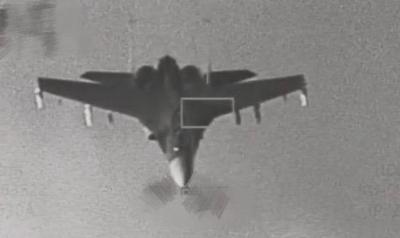Fears surrounding the commercial debut of the China’s Beidou satellite navigation system last week have centered on the development by the Chinese military in recent years of a bomb kit that can transform “dumb” bombs into “smart” ones.
Chief among them is the Lei Shi-6 (LS-6) “Thunder Stone” precision-guided glide bomb first unveiled by the Luoyang Optoelectro Technology Development Center in late 2006. The guidance “fit,” which is attached to conventional bombs and has deployable wings, can support a number of bomb weights, from 50kg to 500kg, Jane’s Defence Weekly reported last year.
Once installed, a “dumb” bomb becomes a “standoff” maneuverable precision-guided bomb similar to the US-developed Joint Attack Direct Munition (JDAM), which relies on US satellites for guidance. Unlike laser-guided weapons, projectiles using satellites for guidance can be used in any weather conditions.
According to Chinese media, the People’s Liberation Army (PLA) Air Force conducted a series of tests of the LS-6 on the Shenyang J-8B starting in 2006.
Relying on the navigation capabilities provided by the Beidou satellites, aircraft pilots could limit their exposure to an enemy’s aircraft and air defense system by releasing their smart bomb from a distance. The LS-6 has a range of 40km when dropped at an altitude of 8,000m and 60km at 10,000m, bringing its ordnance at a speed of Mach 1 to within 15m of a target.
Military experts have said that while Taiwan spends more than US$300 million per Patriot Advanced Capability-3 (PAC-3) fire unit and missiles, the production of guided bombs like as the LS-6 is substantially cheaper. The cost difference means that a far greater number of smart bombs can be built than Taiwan’s Patriot missile units can intercept, although this view does not take the other, less expensive, layers of Taiwan’s air defense architecture into account.
LS-6 bombs could also be mounted on carrier-based aircraft, which China has been developing, giving the People’s Liberation Army Navy a much wider angle from which to direct bombs and missiles against Taiwan. This would severely undermine the PAC-3’s ability to intercept them, given the limitations posed by the Patriot radar’s 90-degree sector coverage.
The Taiwan Affairs Office last week denied the Beidou system would be used by the Chinese military and played down reports in Taiwan that the satellites posed a threat to the region.

Trips for more than 100,000 international and domestic air travelers could be disrupted as China launches a military exercise around Taiwan today, Taiwan’s Civil Aviation Administration (CAA) said yesterday. The exercise could affect nearly 900 flights scheduled to enter the Taipei Flight Information Region (FIR) during the exercise window, it added. A notice issued by the Chinese Civil Aviation Administration showed there would be seven temporary zones around the Taiwan Strait which would be used for live-fire exercises, lasting from 8am to 6pm today. All aircraft are prohibited from entering during exercise, it says. Taipei FIR has 14 international air routes and

Taiwan lacks effective and cost-efficient armaments to intercept rockets, making the planned “T-Dome” interception system necessary, two experts said on Tuesday. The concerns were raised after China’s military fired two waves of rockets during live-fire drills around Taiwan on Tuesday, part of two-day exercises code-named “Justice Mission 2025.” The first wave involved 17 rockets launched at 9am from Pingtan in China’s Fujian Province, according to Lieutenant General Hsieh Jih-sheng (謝日升) of the Office of the Deputy Chief of the General Staff for Intelligence at the Ministry of National Defense. Those rockets landed 70 nautical miles (129.6km) northeast of Keelung without flying over Taiwan,

City buses in Taipei and New Taipei City, as well as the Taipei MRT, would on Saturday begin accepting QR code payments from five electronic payment providers, the Taipei Department of Transportation said yesterday. The new option would allow passengers to use the “transportation QR code” feature from EasyWallet, iPass Money, iCash Pay, Jkopay or PXPay Plus. Passengers should open their preferred electronic payment app, select the “transportation code” — not the regular payment code — unlock it, and scan the code at ticket readers or gates, General Planning Division Director-General Liu Kuo-chu (劉國著) said. People should move through the

The Ministry of National Defense (MND) today released images of the military tracking China’s People's Liberation Army (PLA) movements during the latest round of Chinese drills around Taiwan. The PLA began "Justice Mission 2025" drills today, carrying out live-fire drills, simulated strikes on land and maritime targets, and exercises to blockade the nation's main ports. The exercises are to continue tomorrow, with the PLA announcing sea and air space restrictions for five zones around Taiwan for 10 hours starting from 8:30am. The ministry today released images showing a Chinese J-16 fighter jet tracked by a F-16V Block 20 jet and the